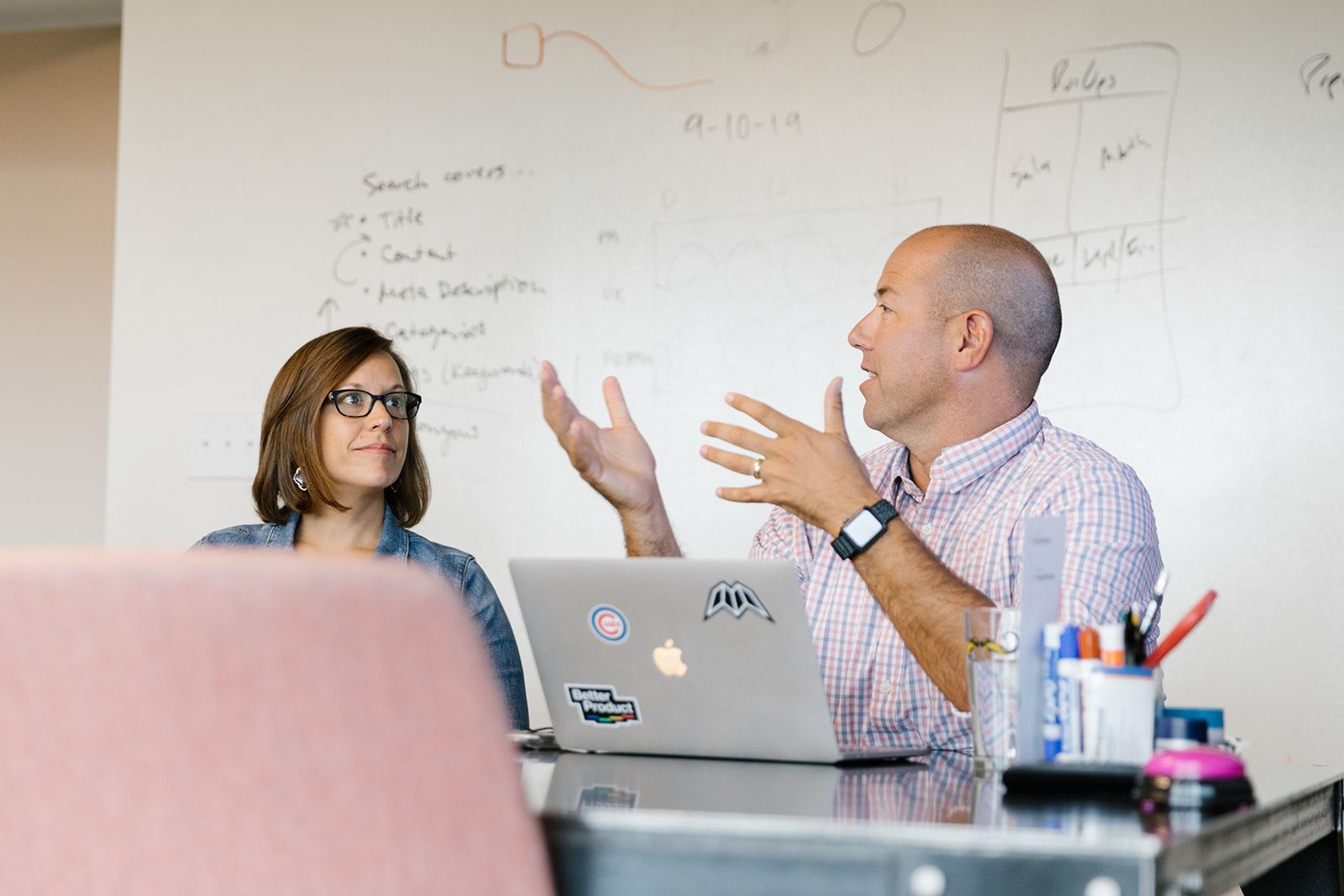
About Innovatemap — 06.20.2022
Feedback as a Gift — How We Engage With Radical Candor

When I was a kid, my mom used to tell me, “If you don’t have anything nice to say, don’t say anything at all.” Intended to encourage kindness, many workplaces adopt this motto. Simple enough right? In reality, a world where we tiptoe around each other, afraid to critique at the risk of bruising someone’s ego is a world deprived of true growth and innovation. We must push each other to grow, sometimes more than we’d like to admit.
But there is a balance. Push too far, and you’ve discouraged your teammate from taking creative risks. Not far enough, and you’ve allowed them to coddiwomple, or march ambitiously in no particular direction.
With innovation at our core, feedback is how we learn what to do more and what to do less. Frequently citing “Radical Candor” by Kim Scott, Lacey Lavies, Executive Partner of Product Strategy & Client Experience, heavily informs the way we think about feedback and the role it plays in our work. She’s always looking to ignite discussion and action among the team and inspire a culture of feedback and growth. Most importantly, Lacey helps us optimize how we give and receive feedback by finding the balance of pushing too far or not enough.
What good feedback looks like
Feedback is all about guidance — conveying what works and what doesn’t. To do this, there are two types of feedback that we emphasize: praise and criticism.
Praise is the stuff that makes us smile: “You did a great job in that meeting today.” Many may stop here. But to really see growth, you must clearly and directly identify what the person did well and the impact it had. For example, “Your presentation in the scope alignment with the client was concise and well-thought out. Your attention to detail has improved generously, and they were excited to continue with us.” In the second example, it’s clear the feedback is intended to guide, not to boast or compliment. The smiles are a nice side effect to the meaningful direction the feedback gives. It’s the difference between one achievement and a pattern of reliable achievement, building trust and credibility.
Criticism, on the other hand, is the stuff that makes us think. Sometimes, it can even make us a little uncomfortable. Since we’ve been trained to “say nothing if we have nothing nice to say,” we have been conditioned to get defensive in the face of criticism. At Innovatemap, criticism is an opportunity for facing obstacles to personal growth head-on. Speaking the truth clearly and directly, especially when the truth is hard to say or hear, is the single most effective way to solve problems.
It’s important to call out that feedback doesn’t personalize. When receiving criticism, it’s essential to separate work from worth. Saying, “the work was not good enough,” doesn’t mean, “you’re not good enough.” We don’t measure our self-worth by the quality of the work we do, and you shouldn’t either.

How we give and receive feedback
With both praise and criticism, how you say it is just as important as what you say. Depending on the person, how you say it should change. We encourage ourselves to learn each other’s work styles which helps us understand how to give feedback effectively. “An easy trap to fall into,” Lacey said, “is giving the type of feedback we ourselves want to hear.” But what feels best to me likely isn’t what will resonate with someone else, so we embrace our different work styles and acknowledge how they affect feedback.
Despite some divergence in delivery, a few characteristics of good feedback exist for all. Feedback must be timely, humble, direct, and clear. Lacey explained, “it’s about challenging directly and showing you care personally, at the same time.” It doesn’t need to come from a place of superiority. It’s about helping someone else achieve their best and tackling the obstacles together by clearly acknowledging them. We find it’s often best to praise in public and criticize in private, and usually giving 3 times as much praise as criticism is a good ratio to follow.
The formula we use for giving effective feedback is situation, behavior, impact. It’s how we apply the feedback principle to our day-to-day.
Here’s an example of praise you could hear around our office, “the examples you talked through in our internal review were spot on. You made your point crystal clear, and it will be so relevant for the client.” It’s clear to the team member what specifically was effective about their actions so she can repeat it.
Here’s an example of criticism, “When you shared your update, you talked really fast. It seemed like you wanted it to be over versus wanting to really enable and inform the team. Flying through the content devalues your message.” The individual knows what didn’t work and why. She really understands the impact of her actions and knows how to improve for next time.
And that is the key to giving feedback — understanding.
For some, receiving feedback proves more uncomfortable than giving it. There are ways the receiver can help increase understanding for more effective feedback loops.
- Listen with the intent to understand, not to respond. Don’t try to explain away the giver’s note.
- Don’t get mad, get curious. Seek to learn more about why they feel that way. Ask questions.
An important part of facilitating meaningful feedback loops is normalizing through routine. “Giving and receiving feedback shouldn’t be something you are amping yourself up for,” Lacey explained, ”it should be weaved into your everyday practices because feedback has an expiration date.” Feedback loses value when you bottle it up and wait to give it (we call this feedback debt). For this reason, we prioritize a culture of consistent, continuous guidance for accelerated growth without limiting the time or place where feedback happens.
What happens without feedback
Perhaps the best demonstration of the importance of feedback is what happens without it. In the absence of both praise and criticism, meaningful growth is impossible to achieve. We need other people to tell us what works and what doesn’t.
Feedback is, at its core, the opportunity to help someone else grow. So not giving quality guidance actually stunts growth. Think about the impact of not addressing an issue. When you internalize the issue, you’re not considering that the same issue may be affecting others. We have an obligation to others to give both criticism and praise, just like we need them to do for us. Not doing so is holding someone back from reaching their potential. And we are all about growth here.
What feedback does for us
Feedback is humbling, rewarding, and encouraging. It’s keeps us sharp and honest. “Ultimately, we foster individual growth to make sure that we’re growing as a team,” Lacey said, “and of course, all of this in the end has great business impact for innovation.” We can’t flourish as a team without first addressing our personal opportunities for growth.
Honesty, excellence, partnership — feedback is at the heart of all of them. With the right balance of praise and criticism, we empower each other to do our best work not just today, but in the long-term. It’s how we grow, how we hold each other accountable, and how we engage with the world.
Key Takeaways
- Feedback is about guidance: what to do more of and what to do less of.
- Both praise and criticism are essential to growth.
- Find the balance of challenging directly and showing you care personally.
- Feedback doesn’t personalize. Saying “the work was not good” doesn’t mean “you’re not good.”
- Feedback must be timely and routine.
- Clear is kind and unclear is unkind.
- Not giving quality feedback stunts growth.
- Listen with the intent to understand, not respond & don’t get mad, get curious.

